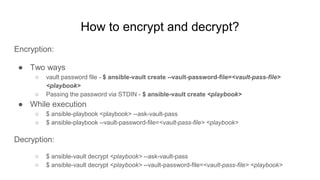Ansible vault - Introductory session
- 1. Ansible Vault - Buvanesh Kumar, RHCA
- 2. About me ŌŚÅ Works for Red Hat in global learning services team ŌŚÅ Contributor to Fedora, Ezhil language foundation ŌŚÅ IRC - buvanesh_kumar ŌŚÅ Twitter - sbuvaneshkumar
- 4. What is Ansible Vault ŌŚÅ Encrypt sensitive data ŌŚÅ Comes as a part of Ansible ŌŚÅ Allows us to safely store encrypted values
- 5. How to encrypt and decrypt? Encryption: ŌŚÅ Two ways ŌŚŗ vault password file - $ ansible-vault create --vault-password-file=<vault-pass-file> <playbook> ŌŚŗ Passing the password via STDIN - $ ansible-vault create <playbook> ŌŚÅ While execution ŌŚŗ $ ansible-playbook <playbook> --ask-vault-pass ŌŚŗ $ ansible-playbook --vault-password-file=<vault-pass-file> <playbook> Decryption: ŌŚŗ $ ansible-vault decrypt <playbook> --ask-vault-pass ŌŚŗ $ ansible-vault decrypt <playbook> --vault-password-file=<vault-pass-file> <playbook>
- 6. What can I encrypt? - Variable files - Inventory files - Templates - Tasks - Playbooks - And almost anything ;) Best practise: Only encrypt sensitive information
- 7. Other commands ŌŚÅ $ ansible-vault edit <file> ŌŚÅ $ ansible-vault rekey <file> ŌŚÅ $ ansible-vault view <file>
- 8. Demo
- 9. Q & A









